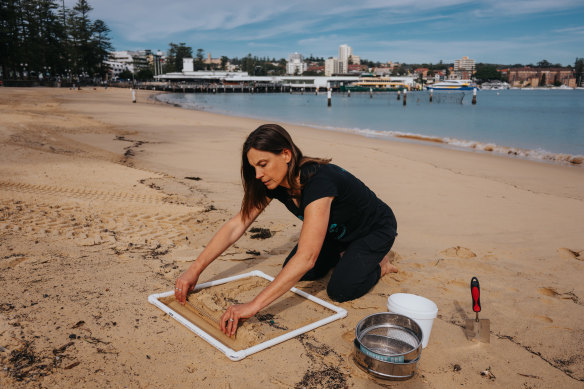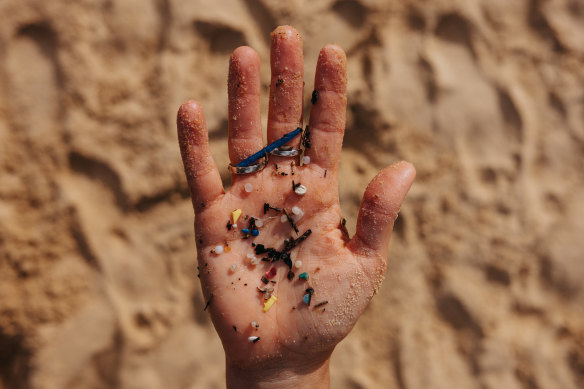This was published 9 months ago
‘Insidious pollutant’: The microplastic hotspots in Sydney Harbour revealed
Manly Cove is one of the worst hotspots for microplastic pollution in Australia, and the tiny particles are widespread throughout Sydney Harbour because of urban stormwater run-off.
Marine scientist Dr Michelle Blewitt, the program director of Australian Microplastic Assessment Project (Ausmap), said Sydney Harbour was “unfortunately filled with microplastics” from consumer litter, industrial waste, and run-off from synthetic playing fields.

Dr Natasha Franklin, science officer at Ausmap, counting microplastics at Manly Cove.Credit: James Brickwood
“The coastal beaches tend to be relatively clear … but around our estuaries and our wetlands there tend to be higher loads because a lot of that micro debris comes down our stormwater network,” Blewitt said. “If your pen falls out of your bag and gets run over by a car, it becomes automatic microplastic.”
Microplastic is defined as plastic particles less than five millimetres, and Ausmap focuses on fragments in the 1-5 millimetre range. Or as Dr Scott Wilson from Macquarie University, who developed Ausmap’s scientific program, puts it: “It’s about the size of a grain of rice.”
This masthead reported last week that microplastics made up 0.5 per cent of the average weight of human brain samples tested in a US study, a 50 per cent increase since 2016. Researchers suggest that plastic may have been acting for decades as an unrecognised “dark matter” driver of global health issues including dementia and plunging male fertility.
Wilson said microplastics were also dangerous for the health of wildlife.

Dr Natasha Franklin shows the microplastics covering her hand after doing a count at Manly Cove.Credit: James Brickwood
“Once we have microplastics in our waterways, it’s really an insidious pollutant in that it gets into everything from plankton through to our largest marine life, whales and penguins potentially,” Wilson said.
“We know the smaller microplastics can move across the stomach wall into the bloodstream and into the organs of those animals, and there is evidence that causes harm. Probably more disturbing is the chemicals associated with these plastics, some are known carcinogens, and some of them are just purely toxic.”
A national citizen science project that started in 2018, Ausmap trains volunteers to count microplastics on shorelines using a consistent methodology. This means the data is considered accurate for each location tested, but not comprehensive because not all locations are tested.
Manly Cove, west of the ferry terminal, has an average concentration of 1075 microplastics per square metre, based on 19 readings between 2022 and 2024 recorded by Ausmap science officer Dr Natasha Franklin. This is the second worst in Australia, behind a site in Adelaide.
The microplastics do not all originate in Manly, but are carried by stormwater into Sydney Harbour and tributaries such as the Parramatta River and Lane Cove River and washed into Manly Cove by ocean currents.
Franklin said a site was considered a microplastic hotspot when there were more than 250 microplastics per square metre. She said Manly Cove had been measuring more than 1500 for most of this year and up to 4000 in one of the most recent readings.
Other beaches in the Manly area, including Collins Flat, have had high readings in the past, but the testing is less frequent. Franklin said it was a concern for Manly’s fragile colony of fairy penguins.
Whale Beach on the northern beaches was the next worst hotspot in Sydney, but only based on a single reading.
Elsewhere in the harbour, multiple readings in the past two years confirm Rose Bay, Athol Beach on Bradleys Head, and Greenwich Baths are all hotspots.
Ausmap also has data collected from 2018-2021, which show other hotspots in the harbour and Parramatta River, including Meadowbank and Watsons Bay.
Cook Park in Kyeemagh and Tower Beach, also known as Planespotting Beach, both on Botany Bay, have previously recorded over 1000 microplastics per square metre, making them among the worst in Australia, but these sites have not had readings done since 2021.
Blewitt said there had been an overall decrease in plastic litter because of regulation of plastic bags and the container deposit scheme for bottles, but the NSW government should recognise that microplastic is a litter item. The NSW Litter Prevention Strategy only targets microplastic that comes from industrial waste.
A spokesperson for the NSW Environment Protection Authority said the strategy focuses on “macro litter” above five millimetres in size, but in doing so it was “effective in preventing larger items from breaking down into micro litter as they leak into the broader environment and waterways”.
“NSW has already more than halved litter since 2018–19, and our goal is to reduce it by 60 per cent by 2030,” the spokesperson said.
“We’re funding groundbreaking research with a broadscale microplastic assessment of 120 estuaries to provide a baseline dataset for surface water microplastic contamination.”
A government paper called NSW Plastics: Next Steps proposes targeting plastics that readily break down into microplastics, plastic microbeads in cleaning products, and plastic microfibres that are released from washing machines when synthetic fabrics are washed.
Get to the heart of what’s happening with climate change and the environment. Sign up for our fortnightly Environment newsletter.